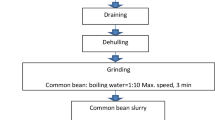Abstract
The boiled seeds ofAbrus precatorius L. are eaten by the residents of the Andaman Islands in India. The seeds were analysed for proximate composition, total (true) protein, seed protein fractions, amino acid profile of seed proteins, minerals and certain antinutritional factors. The seed proteins are rich in most of the essential amino acids, and they are deficient only in cystine and threonine, when compared to the WHO/FAO requirement pattern. The antinutritional factors (total free phenols, tannins, trypsin inhibitor activity and haemagglutinating activity) were also investigated.
Similar content being viewed by others
References
Abdel-Aal EM, Youssef, MM, Adel Shehata A, El-Mehdy AR (1986) Chemical and functional properties of some legume powders. Food Chem 20: 153–156
Altschul AM (ed) (1974) New Protein Foods, London: Academic Press
AOAC (1970) Official Methods of Analysis, Washington DC: Association of Official Analytical chemists
Basha SMM, Beevers L (1975) The development of proteolytic activity and protein degradation during germination ofPisum sativum L. Planta 124: 77–87
Basha SMM, Cherry JP, Young CT (1976) Changes in free amino acids, carbohydrates and proteins of maturing seeds from various peanut (Arachis hypogaea L.) cultivars. Cereal Chem 53: 586–597
Birch GG, Parker KJ, Worgen JT (eds) (1975) Food from Waste, London: Applied Science Publishers
Brain KR (1976) Accumulation of L-DOPA in cultures fromMucuna pruriens. Plant Sci Letts 7: 157–161
Bray HG, Thorne WV (1954) Analysis of phenolic compounds. Meth Biochem Anal 1: 27–52
Burns RR (1971) Methods for estimation of tannin in grainSorghum. Agron J 63: 511–512
Chrispeels MJ, Baumgartner B (1978) Trypsin inhibitor in mungbean cotyledons. Purification, characteristics, subcellular localization and metabolism. Plant Physiol 61: 617–623
Dickman SR, Bray RM (1940) Colorimetric determination of phosphate. Ind Eng Chem Anal Ed 12: 665–668
Gopinathan MC, Babu CR, Chatterjee SR, Abrol YP (1987). Nutritional potential ofVigna minima (Roxb.) Ohiwi and Ohashi: 1. Seed protein content and amino acid composition. Plant Foods. Hum Nutr 36: 345–356
Hooker JD (1973) The Flora of British India (Reprinted) Vol. II. Delhi: Bishen Singh Mahendra Pal Singh, Dehra Dun and Periodical experts
Hove EL (1974) Composition and protein quality of sweet lupin seed, J Sci Food Agric 25: 851–859
Humphries EC (1956) Mineral composition and ash analysis. In: Paech K, Tracey MV (eds) Modern Methods of Plant Analysis, Vol. I. Berlin: Springer Verlag, pp. 468–502
Ignacimuthi S, Babu CR (1987)Vigna radiata var.sublobata (Fabaceae): Economically useful wild relative of urd and mungbean. Econ Bot 41: 418–422
Issac RA, Johnson WC (1975) Collaborative study of wet and dry techniques for the elemental analysis of plant tissue by Atomic Absorption Spectrophotometer. J AOAC 58: 436
Jain SK (1981) Glimpses of Indian Ethnobotany. New Delhi, Bombay, Calcutta: Oxford and IBH Publishing Co
Kihlberg R (1972) The Microbes as a source of food. Ann Rev Microbiol 26: 427–466
Liener IE (1976) Phytoheammagglutinins (phytolectins). Ann Rev Plant Physiol 27: 291–319
Lin S, Njaa LR, Eggum BO, Shen H (1983) Chemical and biological evaluation of silk-worm chrysalid protein. J Sci Food Agric 34: 896–900
Lowry OH, Rosebrough NJ, Farr AL, Randall RJ (1951) Protein measurement with folin phenol reagent. J Biol Chem 193: 265–275
Marangoni A, Alli I (1988) Composition and properties of seeds and pods of the tree legumeProsopis juliflora (DC), J Sci Food Agric 44: 99–110
Meiners CR, Derise NL, Lau HC, Crews MG, Ritchey SJ, Murphy EW (1976) Proximate composition and yield of raw and cooked mature dry legumes J Agric Food Chem 24: 1122–1126
Musquiz M, Burbano C, Rey C, Cassinello M (1989) A chemical study ofLupins hispanicus seed nutritional components. J Sci Food Agric 47: 197–204
Osborne DR, Voogt P (eds) (1978) Calculation of calorific value In: The Analysis of Nutrients in Foods. New York: Academic Press, pp. 239–240
Rajaram N, Janardhanan K (1990) The biochemical composition and nutritional potential of the tribal pulse,Mucuna gigantea (Willd) DC. Plant Foods Hum Nutr 41: 45–51
Ravindran V, Ravindran G (1988) Nutritional and antinutritional characteristics ofMucuna (Mucuna utilis) bean seeds. J Sci Food Agric 46: 71–79
Rivett DE, Tucker DJ, Jones GP (1983) The chemical composition of seeds from some Australian plants. Aust J Agric Res 34: 427–432
WHO/FAO (1973) FAO, Energy and protein requirements. Report of Joint FAO/WHO Adhoc expert committee. Rome: FAO/WHO
Author information
Authors and Affiliations
Rights and permissions
About this article
Cite this article
Rajaram, N., Janardhanan, K. The chemical composition and nutritional potential of the tribal pulse,Abrus precatorius L.. Plant Food Hum Nutr 42, 285–290 (1992). https://doi.org/10.1007/BF02194088
Received:
Accepted:
Issue Date:
DOI: https://doi.org/10.1007/BF02194088



